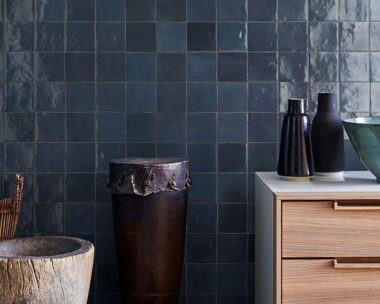When I first heard the expression “herbal ley” it brought to mind visions of a Hawaiian-style lei made from herbs. The idea of a necklace of, say, borage, lavender and thyme was quite appealing in terms of the scent, but I figured it could be risky for those allergic to bee stings.
However, a herbal ley has nothing to do with floral necklaces, and everything to do with enhancing the productivity of your land. The practice came to my attention when an old friend, who’s been growing fruit for years, told me he puts pots of lavender into the forks in the branches of his fruit trees. It’s not exactly a style statement, but it does attract more bees to pollinate the trees.
The Partner thought it was a great idea because he loves lavender and would rather hang it in the trees than underplant with it. It has to look better than the plastic pots stuck halfway up the lime trees, or the half bare, half weedy circles we currently have underneath them.

The beautiful blue flowers of the borage plant are attractive to bees.
All of this led us to the principle of a herbal ley – a living grass ground cover that helps to control and suppress weeds, retain moisture, prevent erosion and attract beneficial insects and bees. It acts as a nutrient fixer and recycler, and there’s no question it looks gorgeous and saves labour.
Trees don’t grow in isolation or surrounded by lawn, or bare earth, so it’s easy to see how a herbal ley can enhance tree health. Bear in mind, though, that in this context, the word “herbal” refers to “herbage” – leafy green ground cover and low-growing plant species.
You can create your own ley for different purposes, so if you want to enhance the look and productivity of your fruit trees, find a mix designed for orchards.

Chamomile is very much at home in an orchard setting.
The way to go about it is to skim off lawn around the tree and then sow “orchard herbal ley” seed. You can buy special mixes from nurseries or create your own combination.
Plant borage, red and white flowering clover, lemon balm, chicory and spring bulbs to attract bees and other insects to fruit trees for pollination, and therefore more fruit.
Planting members of the Umbelliferous (Apiaceae) family such as parsley, carrot, parsnip, coriander and dill will help protect fruit trees from pests. Let them flower, set seed and sow again for next year. Apples like to be underplanted with yarrow, chamomile, borage, clover, chicory and cornflower. The Biological Husbandry Unit (BHU) at Lincoln University notes that they’re also well suited to cow parsley growing as an understorey. Cow parsley and its relatives attract small wasps (safe to humans) which will eat leaf roller caterpillars and codling moth larvae.
For soil fertility and nutrients, plant clover and lupin for nitrogen fixing, and comfrey for potassium.

Cow parsley is recommended as an understorey for apple trees.
The Koanga Institute’s herbal ley mix contains alfalfa, phacelia, buckwheat, red clover, white clover, subterranean clover, yarrow, plantain, chicory, sorrel, dandelion and parsnip. They recommend planting a mix of heritage bulbs around the drip lines of your fruit trees. The bulbs grow when the trees are dormant and compost down available nutrients for the feeder roots of your trees in spring.
They also suggest planting comfrey root around the drip line area of your trees to add more potential for mineral accumulation, tree health and to recycle minerals from the subsoil.
It’s not too late to sow or plant a herbal ley if your soil is still moist. Sneak a bit of lavender in too, so your herbal ley feeds your trees, your senses and you.




